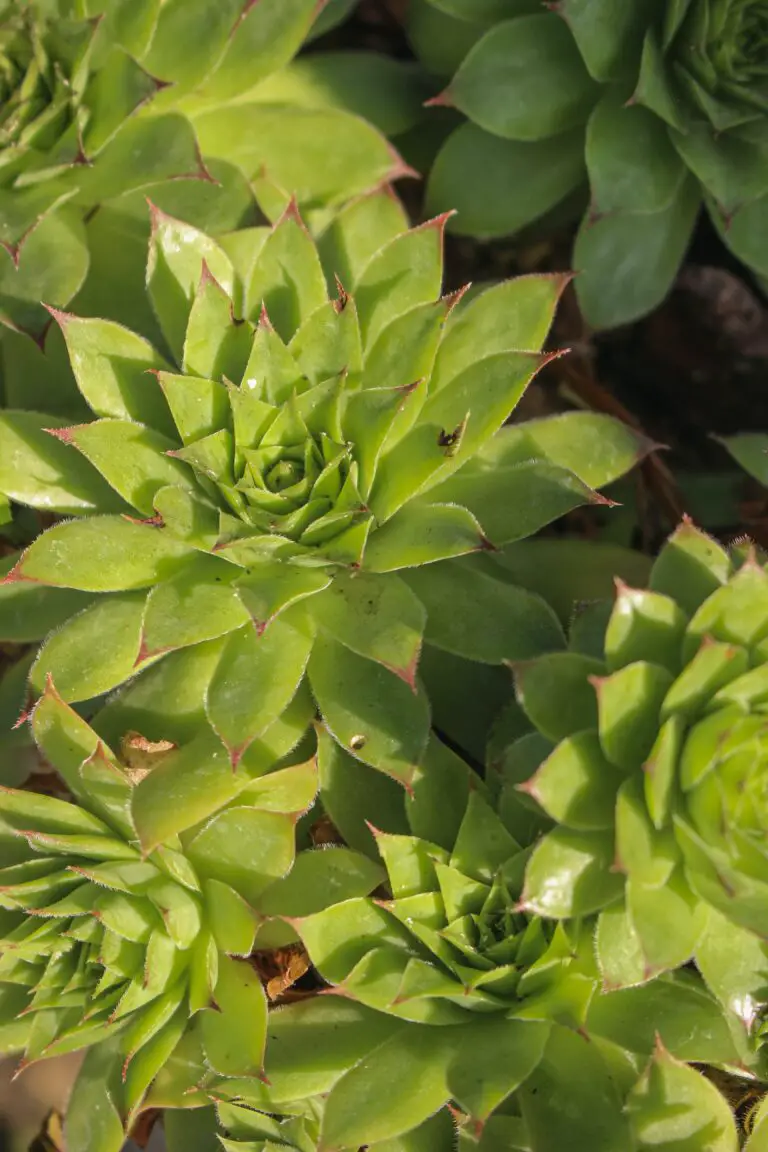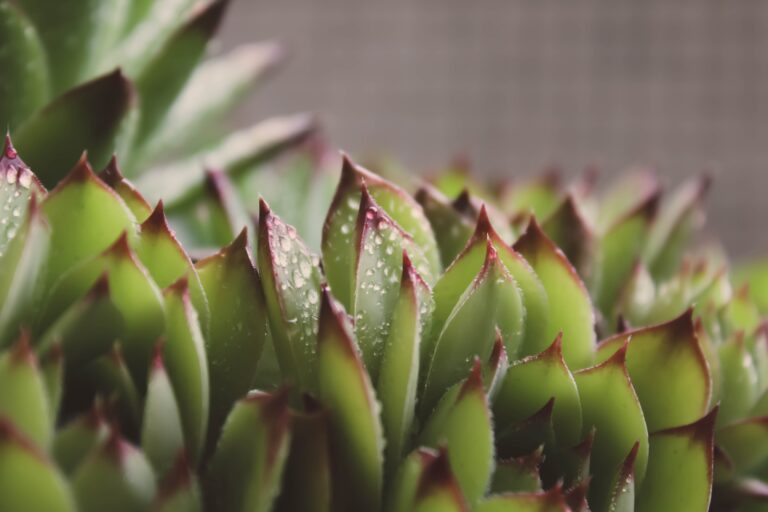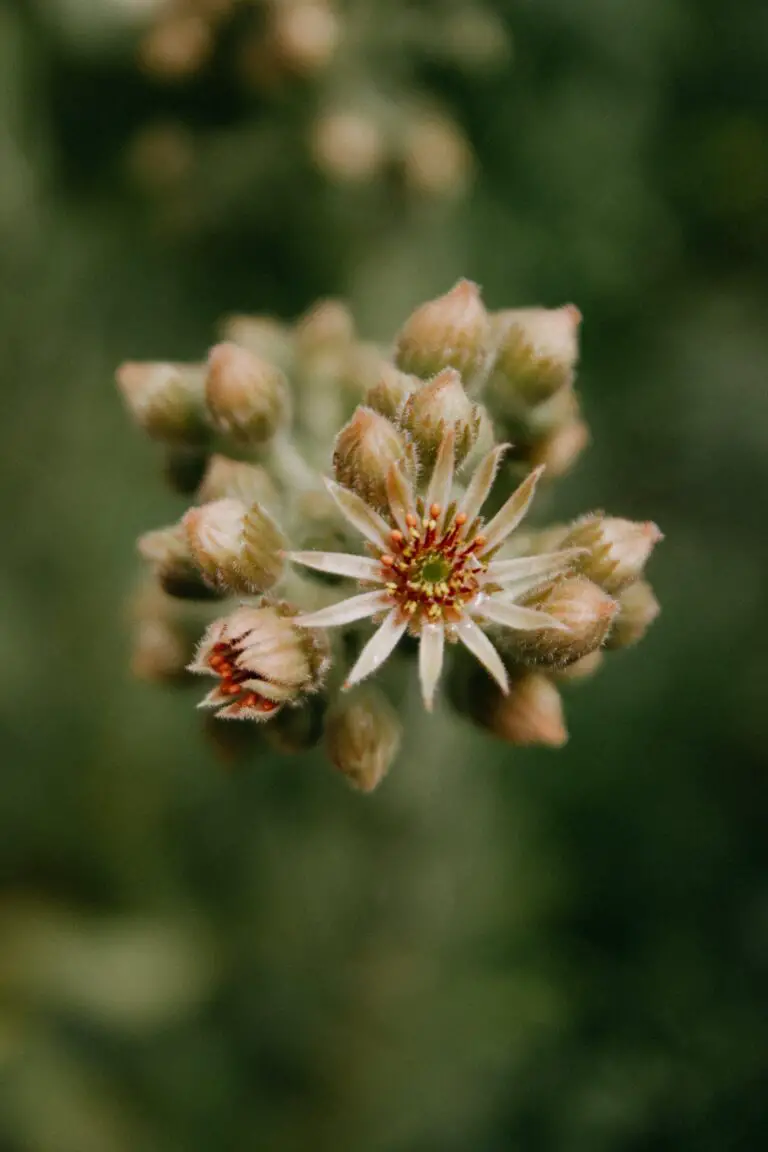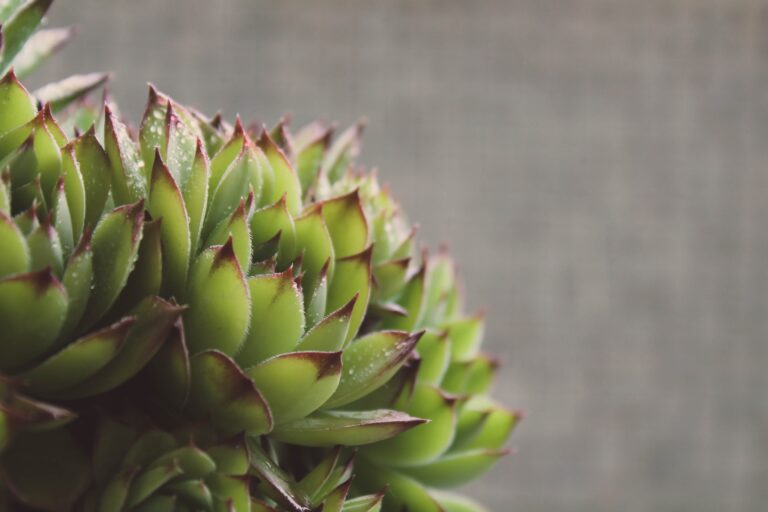Introduction
Imagine a succulent that radiates vitality just as strongly as the famous Mount Pilatus it hails from. Meet the Sempervivum Pilatus, an alpine gem that is as resilient as it is captivating. This tubby treasure, with its rosette formation, alludes to an artist’s brush strokes, each leaf a testament to nature’s ingenuity. Its allure not only lies in its robustness to weather extremes but also in its charm as a coveted jewel in succulent collections.
Renowned for its adaptability, the Sempervivum Pilatus is the mountaineer of the plant world, thriving where others may falter. The spirals of plump leaves, sometimes tipped with an innocent blush, create a spectacle that mimics the rugged landscapes they originate from. This plant’s tale is one of perseverance and beauty—a true survivalist that enhances any rockery, container, or green space.
Delving into the world of these hardy succulents can transform your approach to gardening, as showcased in our guide to cultivating the perfect succulent growth. Here, enthusiasts discover the secret soils and strategies that promise to elevate their green sanctuaries. But what truly sets our beloved Pilatus apart? Its ease of propagation, for one, invites gardeners to witness the birth of new life, as tiny chicks spring forth with the promise of continuity.
To truly appreciate the propagation process, look no further than this illuminating tutorial:
Embark on a horticultural journey with the Sempervivum Pilatus, and experience firsthand why this mountainous sensation is more than just a plant—it’s a testament to resilience and aesthetic allure. Its foliage, a parade of texture and color, stands against the elements, ensuring that each rosette’s story is one of triumph and splendor.
Origin and Botanical Profile
Let’s scale the heights of horticultural intrigue as we delve into the alpine origins of Sempervivum Pilatus, a jewel in the crown of the sempervivum family. Imagine the rugged, breathtaking slopes of the Swiss Alps, where these resilient succulents emerge from the rocky crags, harnessing the sparse moisture and thin air to thrive. It’s the ultimate tale of botanical tenacity, and our Pilatus variety is no exception.
The botanical profile of Sempervivum Pilatus is as fascinating as its high-altitude home. With a rosette structure that rivals the symmetry of geometric art, this succulent’s leaves are a testament to nature’s precision. Each leaf is a thick, fleshy marvel, designed to store water and ensure survival in the most inhospitable environments. The color palette of these mountain gems can shift with the seasons, from a lush green to deep burgundy, reflecting the ever-changing mountain landscape.

Anyone aspiring to embrace these rugged beauties within their own garden sanctuary would benefit from understanding their requirements. Sempervivum Pilatus, like its relatives, yearns for a simulation of its native alpine conditions. Ensuring good drainage and ample exposure to the midday sun mirrors the rocky outcrops where it prospers so vibrantly in the wild.
Discover nurturing tips and insights to make your garden the next best thing to a mountain retreat by exploring, “The Ultimate Guide to Succulent Soil: Tips for Perfect Plant Growth” on our website.
Their presence among the Sempervivum species is like finding a treasure trove. In clusters, they create a carpet of hardy, evergreen splendor, reminding us of nature’s resilience and our role in safeguarding these botanical treasures.
The Sempervivum Spectrum
While Sempervivum Pilatus captivates with its robust nature and unique coloration, it’s but one variant in a broad spectrum of Sempervivum species, each with its own distinctive flair. Their commonalities bind them as a family – their survival tactics and rosette formation – but their individual hues, sizes, and leaf textures invite endless fascination and collection potential for succulent enthusiasts worldwide.
Ideal Growing Conditions
Imagine the perfect mountain gem, tenaciously clinging to rocky precipices, basking in the crisp sunlight—this is Sempervivum Pilatus in its natural habitat. To replicate these conditions and cultivate Sempervivum Pilatus at home, here’s how you can recreate the alpine paradise in your own backyard or window sill!
First things first, these hardy succulents crave sunlight like a hiker thirsts for a clear mountain spring. Aim to provide your Sempervivum Pilatus with a generous dose of sunlight—around six hours of direct exposure is the sweet spot. The morning sun is akin to a gentle nudge, ideal for these beauties to open their rosettes to the day. While they can endure partial shade, too much shadow will dampen their spirit and induce a growth stunt akin to a plateaued mountaineer.

Now, let’s talk temperature rhythms. Just as the mountain air oscillates between the warmth of noon and the chill of night, Sempervivum Pilatus thrives in a temperature range that swings rather melodically. These succulents are robust—weathering conditions through USDA hardiness zones 3 to 8 with ease. A word of advice: extend a little extra care during scorching summers and deep freezes, as both extremes are where even the stoutest mountaineers can falter.
When it comes to soil selection, think of the loose, well-draining ground you’d encounter on a highland trail. A fertile loam with a dash of gritty sand or perlite is a good starting point. Drainage is paramount—it’s the difference between a flourishing emerald rosette and a sorrowful brown wilt. If you’re planting directly into the garden, consider edging the bed with rocks that whisper tales of their alpine ancestors.
Neatly embedded into this article is a hidden trove of knowledge—further insights await for those curious about growing succulents with panache. The path to a verdant utopia decorated with the lush greens and radiant blooms of various succulents is but a click away. Dive deeper into the nuances of succulent care and unravel the tapestry of tips that ensure a flourishing green expanse!
In swaying to the melodies of mountain winds, dancing in the dappled sunlight, and nesting in the cool embrace of mineral-rich soils, your Sempervivum Pilatus will not just survive; it will thrive, wave after majestic wave.
Planting and Propagation Techniques
Join us on a gardening adventure as we delve into the world of Sempervivum Pilatus, a robust alpine succulent that adds a touch of rugged elegance to any garden. Preparing to cultivate this mountain gem can be an exciting venture akin to unearthing treasure. Let’s dig into the secrets of successfully planting and propagating this resilient beauty.
Firstly, envision a container or garden spot with well-draining soil. Imagine your Sempervivum Pilatus basking in sunlight, their green rosettes with ruby-red tips twinkling like jewels in the light. Choose a sunny location, as these plants originate from the high altitudes of Europe, thriving in the full gaze of the sun’s rays.

Picture your plants developing into hardy clumps, resistant to frost and drought. In planting, create shallow holes to accommodate the roots and press the earth around them gently. You can practically feel the firm soil that carries your Sempervivum on the journey to becoming stalwarts of your garden.
When it comes to propagation, imagine creating a lineage of succulents from a single ancestor. As your Sempervivum Pilatus matures, it produces offsets – aptly called ‘pups’ – ready to be gently detached and cultivated into new, thriving plants. The process is remarkably straightforward, but no less magical. Separate the pups from the parent rosette during the growing season and nestle them into their new homes, ensuring good soil contact.
Visualize the offsets taking root and establishing themselves as independents, each capturing the essence of their parent plant yet contributing their unique character to your collection. With minimal care, they’ll prosper, turning your garden into a living tapestry of texture and color.
Indeed, planting and propagating Sempervivum Pilatus is less about stringent rules and more about embarking on a fulfilling journey with these awe-inspiring succulents. With these techniques, you can almost see the waves of Sempervivum transforming your space into a mountainous Eden.
Maintenance and Care Tips
Imagine the strong, enduring sempervivum—known to its fans as the “Sempervivum Pilatus”—boldly spreading its lush rosettes on the stony ribs of mountains. This hardy gem desires not just to survive but to thrive under your guardianship. Here’s how you can be the champion of its well-being.
Watering with Wisdom
The Pilatus variety is a maestro of moisture management, needing only the occasional drink to sustain its fleshy leaves. Mimic the sporadic mountain rains by soaking the soil thoroughly, then allowing it to dry completely before the next watering session. Overly damp conditions are an open invitation to root rot, so use a ‘less is more’ approach and feel the soil’s moisture level before deciding to water.
Nourishment Know-How
While the sempervivum can flourish in lean, unforgiving soils, a touch of kindness in form of well-balanced fertilizer during the growing season can encourage a flourish of foliage. Feed it sparingly, though, as excessive nutrients can lead to leggy plants, more susceptible to pests and other woes.
The Pests and the Pilatus
Just as a skilled gardener knows how to nourish, so too must they know how to defend. Typical enemies of the sempervivum include aphids and mealybugs, infiltrators that can be deterred by a vigilant eye and a gentle spray of water or insecticidal soap. Keep an eye on those nooks and crannies—the dense rosettes may hide the early signs of an invasion.
And that’s not all; you must stand guard against fungal foes. A well-drained soil ensures that fungal diseases don’t find a home among the roots of your mountainous jewel. When they do, snip the affected areas with sterilized scissors and adjust your care routine to prevent future outbreaks. Always remember, a resilient Pilatus begins with a proactive caretaker.
Sempervivum Pilatus holds a natural elixir of resilience, but it surely blossoms with the thoughtful touch of an attentive gardener. Care for it well, and it will reward you with its stalwart beauty, an echo of alpine grandeur in your own living space.

Design Ideas for Sempervivum Pilatus
When the alpine splendor of Sempervivum Pilatus is mentioned, garden enthusiasts’ eyes light up with the thought of this botanical jewel embellishing their landscapes. Imagine these succulent rosettes, mirroring the rugged beauty of mountain crests, nestled in your garden. Let’s dive into the high-altitude charm of this plant and explore innovative ways to make it the cornerstone of your outdoor haven.
Rugged Elegance in Rock Gardens
Nothing says ‘mountain gem’ quite like a rock garden speckled with the lush, green rosettes of Sempervivum Pilatus. Their resilience pairs perfectly with the hardiness of alpine plants, creating a miniature highland retreat right in your backyard. Conjure up images of the jagged Pilatus massif as you position these hardy succulents among the stones, crafting a natural tapestry that’s both whimsical and wild.
Container Arrangements: Peaks in Pots
Celebrate the majesty of Sempervivum Pilatus by elevating it—literally—in containers. An assortment of terracotta pots, arranged at different heights, can mimic the varying altitudes of its natural habitat. Not only does this technique grant a panoramic view of their beauty, but it also aids in drainage, something these mountain dwellers will love. The end result is a striking display that captures the rugged essence of these plants, making a captivating focal point on patios or balconies.
As Ground Cover: A Tapestry of Texture
Imagine stepping outside to a vivid carpet of Sempervivum Pilatus, where the vigorous growth of these succulents serves as living mulch. Their tight, evergreen rosettes spread quickly, providing a dense cover that outcompetes weeds and reduces maintenance. Along pathways or spilling over retaining walls, these succulents can thrive with minimal care, creating an intricate green quilt that adds allure to your garden throughout the year.
Whether it’s the centerpiece of a miniature range in your rock garden or the star of a tiered pot arrangement, Sempervivum Pilatus never fails to enhance the landscape. The resilience and ease of care they offer make them a top choice for gardeners looking to add a touch of nature-crafted architecture to their open-air spaces. Now, let’s witness an example of this splendor:

The image above captures the essence of Sempervivum Pilatus in its prime—a convincing ambassador for introducing this succulent into your garden. The keyword isn’t just a name; it signifies a living sculpture, a piece of the Swiss Alps transferred into our homes and hearts.
Troubleshooting Common Issues
Every gardener treasures the moment they can introduce a Sempervivum Pilatus, also celebrated as the ‘Mountain Gem’, to their green sanctuary. With its rosettes echoing the serenity of alpine landscapes, it’s clear why it captures so many hearts. However, akin to any treasured gem, sometimes it doesn’t shimmer as it should. Let’s delve into frequent hurdles you might encounter and unfurl some sage advice on nurturing your Sempervivum back to its majestic state.
Fighting Off Fungal Foes
No one likes to see their plant companions struggle with fungal diseases – those sneaky intruders that leave your Sempervivum Pilatus looking less than pristine. Picture this: You find your beloved plant, once a symbol of rugged endurance, with its leaves turning soft and discolored. That’s a telltale sign of rot – often due to overly moist conditions. Combat this by ensuring your watering regimen is conservative. Only hydrate when the soil is dry to the touch, and be certain the container has adequate drainage. Embrace the art of underwatering, as sempervivums prefer to err on the side of drought.
Preventing Pesky Pests
Encountering pests can be a disheartening chapter in your Sempervivum story. Aphids, for one, could decide to throw a banquet on your plant’s sap, while spider mites spin their nuisance webs. The key here is early detection and intervention. If you spot these critters, act swiftly with insecticidal soap or neem oil treatments. Remember, like a good chess player, always think a few moves ahead. Keep a watchful eye and address the first signs of trouble before they escalate.
Dealing with Dehydration Drama
Imagine climbing a mountain only to find the peak devoid of snow – disappointing, right? Similarly, spotting your Sempervivum’s leaves wrinkling and wilting from dehydration can cause a gardener’s spirit to plummet. Sempervivum Pilatus, despite its hardiness, yearns for that sip of water when the soil is parched. Water deeply, but infrequently, to mimic the mountain rains it evolved to thrive in. This approach encourages robust root systems, akin to a climber’s secure grip on rocky ledges.
Visual learners, rejoice! For those who prefer a more dynamic experience, let’s watch a video illustrating some hands-on care tips for your Sempervivum. It’s one thing to read about care strategies, but seeing them in action brings a whole new level of understanding.
Cultivating a Sempervivum Pilatus is a journey filled with lessons and rewards. By staying vigilant and responsive, you’ll be well on your way to mastering the care of these alpine jewels. Keep in mind these battle-tested solutions and your Sempervivum Pilatus will continue to be a testament to the beauty and resilience of nature, nestled in your garden, standing proud like its namesake mountain.
Conservation and Environmental Importance of Sempervivum Pilatus
The majestic alpine jewel, Sempervivum Pilatus, is more than just a visual marvel nestled in the rugged cliffs; it’s a pivotal piece of the ecological puzzle in its mountainous realm. Conservation of this succulent isn’t a mere preference but a crucial necessity. Picture this: a sprawling sea of cushion-like rosettes, each a mini-ecosystem, supporting myriad forms of life from industrious pollinators to microscopic organisms. Let’s dive into why safeguarding the Sempervivum Pilatus is essential for the vitality of its high-altitude homeland.
Imagine a hillside without these hardy plants; erosion would have a field day. The intricate root systems of Sempervivum Pilatus act like nature’s web, locking soil in place and preventing landslides. With a surge in unpredictable weather patterns, their role as environmental stabilizers is now more significant than ever. Isn’t it remarkable how these small, resilient plants can have such a massive impact on their environment?
Yet, the environmental importance of Sempervivum Pilatus doesn’t stop at erosion control. These succulents provide a lush oasis for insects in an otherwise inhospitable terrain. Take the humble honeybee, which relies on the nectar from the Sempervivum blooms. By protecting these green gems, we are indirectly ensuring the survival of key pollinators, which are fundamental to maintaining biodiversity.
The Role of Sempervivum Pilatus in Its Natural Habitat
Moreover, the green rosettes of Sempervivum Pilatus contribute to the overall health of their ecosystems by creating microclimates. During the day, they absorb sunlight, and at night, they release retained heat, offering warmth to the surrounding microfauna. It’s a tiny climate control system that works round the clock, providing a safety net for many species, especially as temperatures around the globe fluctuate drastically.
Furthermore, they’re even a part of the local folklore! Residents often share tales of how these “mountain guardians” bring fortune to those who care for them, blending environmental knowledge with cultural heritage. This merger of tradition and ecology enhances the local commitment to conservation efforts—a key factor in preserving the longevity of Sempervivum Pilatus.
Conservation initiatives are the lifeline for the protection and sustainability of Sempervivum Pilatus. They are not merely ornamental; their existence is interwoven with the air, water, soil, and life around them. As stewards of the earth, it’s our privilege to ensure that this ‘mountain gem’ continues to thrive, warding off the threats of habitat destruction and climate change.
Frequently Asked Questions: Nurturing Your Sempervivum Pilatus
Welcome to the verdant world of Sempervivum Pilatus, the alpine succulent that’s staking its claim in gardens high and low! Let’s explore some of the frequently asked questions that’ll have this mountain gem thriving under your care.

What’s the Secret to a Happy Sempervivum Pilatus?
Imagine your Sempervivum Pilatus perched above a tranquil mountain range, basking in the crisp air. To replicate this bliss at home, give it bright, indirect light and a quick-draining soil mix. Ensure the pot has a drainage hole to avoid water-logged roots resembling soggy hiking boots – a definite no-no for these drought-lovers!
How Often Should I Water My Sempervivum Pilatus?
Think of watering like a refreshing mountain dew, not a downpour. Let the soil dry out between waterings, then give your Pilatus a thorough soak. Overwatering is the slipperiest slope to root rot, so keep it moderate, just like those spring rains in the hills.
Can I Propagate My Sempervivum Pilatus?
Absolutely! It’s like discovering a hillside of these beauties during a hike. Offsets, or “pups”, will sprout around the mother plant. With a little twist and a gentle pull, separate these pups once they have their own roots, and pot them up. Voila, more Pilatus to go around!
What are Common Issues and How Do I Combat Them?
Even the hardiest mountain flora face trials. Aphids may decide your Sempervivum Pilatus is their next campsite. If you spot these uninvited guests, dispatch them with a spray of water or insecticidal soap. And keep an eye out for rot, which can sneak in with excessive watering or poor drainage. Pilatus prefers to stay high and dry!
Final Care Tips for Sempervivum Pilatus Aficionados?
Remember, these succulents are real troopers when it comes to temperature swings, just like their natural alpine habitats. However, while they can endure a frosty night, they don’t fancy sitting in wet soil for too long. Provide ample sunlight, a lean towards under-watering, and watch as your Pilatus flourishes, echoing the resilience of the mountain ranges it calls home.



